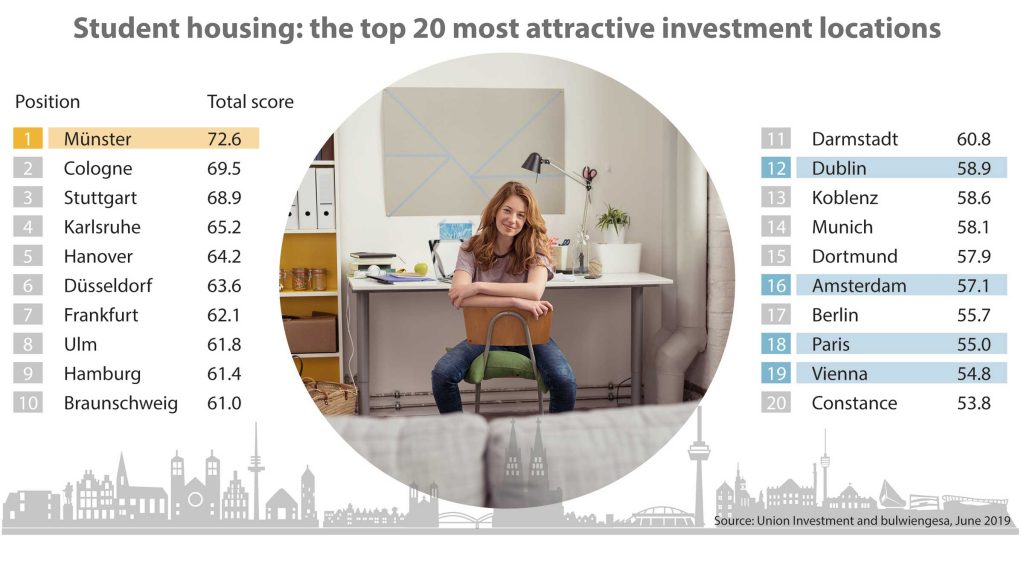The university city of Münster, with almost 60,000 students, is the most attractive location for investment in new student housing. That is the finding of a new city ranking by Union Investment and bulwiengesa, part of an in-depth study comparing supply and demand in this sector across 61 German cities using 18 different metrics. Münster is followed at the top of the ranking by Cologne, Stuttgart, Karlsruhe and Hanover. The lowest ranked city is Trier – below Kaiserslautern, Bamberg, Greifswald and Chemnitz. The study also examines four non-German cities: Dublin, Amsterdam, Paris and Vienna, all of which ranked in the top third.
“The
top 20 cities with the best conditions for investment in the student
housing sector are an interesting mix comprising all seven German Class A
cities, four major European university cities,
plus a large number of ‘hidden champions’. A strategy that focuses
exclusively on Class A cities ignores the opportunities that Münster,
Karlsruhe, Hanover, Ulm, Braunschweig, Darmstadt and Koblenz in
particular have to offer,” said Felix Embacher, Head of
Division Microliving at bulwiengesa.
According
to the study, the combined market potential for student apartments
above EUR 500 per month (all-in) in the 61 German university cities
surveyed is approximately 67,500 units. In the Class
A cities alone, there is potential demand for around 29,500 student
apartments – a 44% share of this price segment. The authors view EUR 500
per month as the threshold value for investor interest, based on
current land prices and construction costs. The potential
in this segment is particularly high in Munich and Cologne, followed by
Hamburg, Berlin and Stuttgart. The cities with the lowest potential in
this segment are Bamberg, Passau, Freiburg im Breisgau, Regensburg and
Dresden.
In
the next price segment, EUR 600–700 per month (all-in), the total
market potential is around 18,600 units. In the top price segment, above
EUR 700 per month (all-in), the estimated demand for
new student apartments is around 12,700 units.
Lack of affordable student housing concepts
“As the sector undergoes dynamic expansion of supply and increasing
professionalism through private-sector players, we should not overlook
the enormous potential of the mid-price segment,” says Henrik von
Bothmer, Investment Manager Micro-Living at Union Investment.
As
discussed in the previous year’s report by Union Investment and
bulwiengesa on Micro-Living in Europe, there is a great deal of
potential in this mid-range bracket, i.e. EUR 400–500 per month
(all-in). “The only way to provide the mid-price accommodation that the
market demands and that would be profitable for developers and
investors, especially in sought-after cities and locations, is to create
simpler housing concepts, for example with shared
kitchens or bathrooms.” Public authorities could also help plug the gap
in supply by relaxing certain building control requirements, especially
in terms of parking spaces and greater harmonisation of state building
codes.
Post-boom adjustment
The study concludes that there are attractive opportunities for
investment in new student housing across the selected university cities
during the current market cycle. However, investors should also bear in
mind that the student housing asset class emerged
during an economic boom period. “Rental expectations and appreciation
are likely to be more modest in future as the market will be unable to
maintain the price dynamics of the start-up phase.
Whatever
happens, there are some fascinating lessons in store for the student
housing asset class,” said Georg-Christian Rueb, Portfolio Manager
Micro-Living at Union Investment.
Source : Company

 Le mie ricette per la real estate community
Le mie ricette per la real estate community